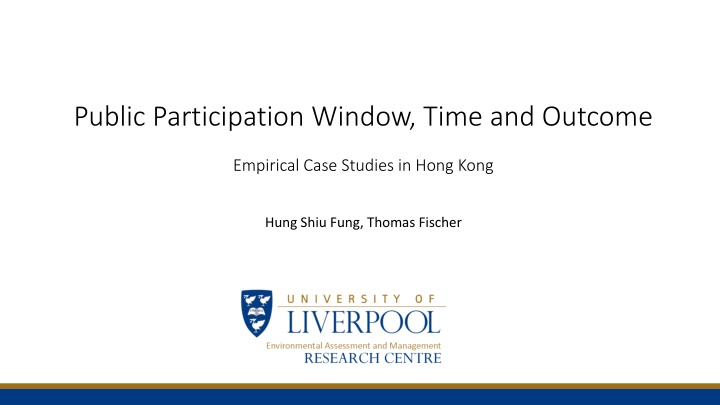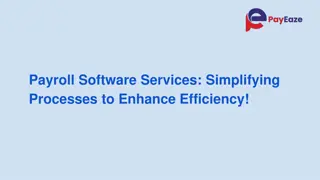
Empirical Case Studies of Public Participation in Hong Kong EIA System
Explore the empirical case studies of public participation in Hong Kong's Environmental Impact Assessment (EIA) system, focusing on biodiversity conservation efforts in Tung Chung. Discover how public engagement, major events, and negotiation processes shape project outcomes in environmental decision-making.
Download Presentation

Please find below an Image/Link to download the presentation.
The content on the website is provided AS IS for your information and personal use only. It may not be sold, licensed, or shared on other websites without obtaining consent from the author. If you encounter any issues during the download, it is possible that the publisher has removed the file from their server.
You are allowed to download the files provided on this website for personal or commercial use, subject to the condition that they are used lawfully. All files are the property of their respective owners.
The content on the website is provided AS IS for your information and personal use only. It may not be sold, licensed, or shared on other websites without obtaining consent from the author.
E N D
Presentation Transcript
Public Participation Window, Time and Outcome Empirical Case Studies in Hong Kong Hung Shiu Fung, Thomas Fischer
Introduction Public participation is mostly considered as important, because: should contribute to the identification and resolution of conflicts and facilitate project implementation (Glucker et al, 2013) could help solving problems through suggestions of concepts, solutions and mobilizing resources (O Faircheallaigh, 2010) Is it the case? How does it work?
Overview of Hong Kong EIA System Mainly governed by Environmental Protection Department (EPD) Environmental Permit based EIA findings would be reflected in permit conditions TWO statutory Public Inspection windows May require Stakeholder/ Community Liaison in the Environmental Permit Public inspection Stakeholder Liaison Public inspection Follow ups Permit EIA Report Project Profile /Study Brief EIA Process Project Implementation
Case 1: Biodiversity Conservation in Tung Chung Part of the Tung Chung New Town Expansion Planning Study Tung Ching River and Bay was known for its aquatic and coastal biodiversity Green groups demanded keep it as it was
Case 1: Major EIA and project events EIA Report Approval 3rd Project Profile & Study Brief Project Profile Submission Study Brief Issued EIA Report Submission Environmental Permit Approval 2nd Project Profile & Study Brief 2007 2012 2014 2013 2015 2016 Stage 1 Public Engagement Stage 3 Public Engagement & Drafted Plan release Finalized Plan release Stage 2 Public Engagement & Start Drafting Outline Development plan Revised Concept Plan
Case 1 Major Negotiation events Proposed River Park added to Project Profile Conservation measures stated as Permit Conditions Required to conduct studies on concerned area and species 2nd Project Profile & Study Brief Project Profile Submission Study Brief Issued Environmental Permit Approval 3rd Project Profile & Study Brief EIA Report Approval EIA Report Submission Concerns about potential damage to ecosystem Request no work at the river and bay area 2016 2015 2012 2013 2014 Finalized Plan release Stage 1 Public Engagement To be studied Stage 3 Public Engagement & Drafted Plan release River Park and Boundary of conservation Area Proposed Stage 2 Public Engagement Will implement conservation measures, base of EIA result
Case 1: Outcome The lobbying and negotiation took 2 years The river and bay area was modified as part of the storm water management measures Bay area was zoned as Coastal Protection Area River park was viewed as a compromised measure
Case 2: Nuisance at Telegraph Bay Barging Point Part of the South Island Line East Railway Extension Project The railway was generally well Perceived Concerns over the noise and air impact associated with the barging activities
Case 2: Major EIA and Project Events Project Profile Submission Environmental Permit Approved Study Brief Issued EIA Report Submission & Approval Community liaison Group meetings 2008 2011 2009 2010 2015 2016 Gazette of the use of Telegraph Bay Barging Point Preliminary Design Start Project Completion Main civil works Contracts awarded Detail Design Start Green light from Government
Case 2: Major Negotiation Events (Impact Predicted to be within Criteria) Community Liaison Required as Permit Condition EIA Report Submission & Approval Environmental Permit Approved Community liaison Group meetings Concerns about local nuisance Request Additional Monitoring and Mitigation Measures 2011 2010 Objection to the use of site Main civil works Contracts awarded Additional Monitoring Mitigation Measures Implemented Gazette of the use of Telegraph Bay Barging Point
Case 2: Outcome Requests Results Request from the local community changed from prohibiting the use to minimizing nuisance Negotiation focused on the contractor and site management Significant Influence to the construction work Use other barging point Enhancement of Barging Point Design Additional Monitoring Measures to Control Trucks Type and Speed Scheduling the works of heavy machineries Enhancement of Landscape reinstatement Partly
Analysis and Discussion Early is a relative term Different concerns associated with different project stage Necessary to engage in both the EIA and Project Implementation Project Implementation and EIA works in parallel, but not directly linked The status of the project implementation usually not transparent Project Profile /Study Brief EIA Report Permit Follow ups Detail Design Finalized Design Construction Preliminary Design Green light
Conclusion Public Participation in EIA have potentials to influence project design and solve socio-environmental conflicts Having multiple participation windows helps Neither connected to each other nor design for continuous negotiation Depends heavily on the will, determination and know how Cases that made significant change are not common Frustration when requests got dismissed Should EIA install provisions to align public comments with project implementation schedule?




















